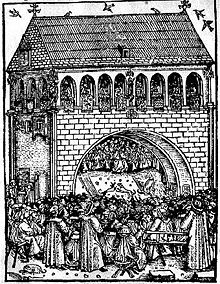Healing chair
The Heiltumstuhl was a building erected between 1483 and 1485 in Vienna on the edge of Stephansplatz for the relics and church treasures, which was removed in 1699 as an obstacle to traffic.
history
In the High Middle Ages , Stephansplatz was bordered in the west by a row of one-story houses that ran between today's Stock-im-Eisen- Platz and Rotenturmstrasse . Part of the building complex were the Zinnentor from 1466 between the choir and the church locksmith's house and the Mesnertor, also built in 1466, on today's corner of Stephansplatz and Rotenturmstrasse.
Across this row of houses stood the Heiltumstuhl, which was built under the church architect Niklas Teschler as a place of worshiping relics . It consisted of an arch with a loggia-like upper floor, which consisted of a rectangular hall with 22 (?) Pointed arched windows, eight each on the long sides and three each on the narrow sides. From 1486 onwards, the relics of St. Stephen were shown to the people from the healing chair on every first Sunday after Easter , the so-called White Sunday . This also happened at special celebrations, such as weddings of the ruling house. Precious fabrics were hung from the windows, benches were set up on the street spanned by the healing chair, and the cathedral treasure was brought from the reliquary treasure chamber in a procession to the healing chair.
There were healing instructions in many large cities of the Regnum Teutonicum (Kingdom of the Germans) (Aachen, Regensburg and many others), but only in Vienna (perhaps also in Prague) was there a bricked healing chair. Elsewhere they were made of wood, decorated and dismantled after the end of the healing instruction. The foundations of the Heiltumstuhl were found during the construction of the U1 underground line .
In the run-up to the Turkish wars , many valuables were melted down and the proceeds invested in the fight against the Ottomans. This also applied to the reliquaries that were shown in the Heiltumstuhl: One of the most serious of such interventions in church assets was the confiscation of the church treasures in 1526. In the case of St. Stephen's Cathedral in Vienna alone, 3000 marks silver (approx. 700 kg) and 15 marks gold (approx , 5 kg) melted down. In addition, the interest in healing directives in the context of the development of the Reformation and the associated rejection of the veneration of saints died out. In 1526 the last healing instruction took place from the healing chair.
The building gradually became a traffic obstacle and was removed around 1699. Although it stood for about 200 years where the pharmacy is located on Stephansplatz today, it is hardly known and is not mentioned in exhibitions in the Vienna Museum or the Dom Museum .
See also
Web links
- Heiltumstuhl on Stephansplatz ( Memento from July 28, 2004 in the Internet Archive )
Individual evidence
- ↑ ABC_zur_Volkskunde , accessed on June 16, 2011.
- ↑ Reinhard H. Gruber: 500 years of the Reformation and no iconoclasm in St. Stephan. In: The Cathedral. Bulletin of the Vienna Cathedral Conservation Association. Episode 2/2017 ZDB -ID 1054178-0 . P. 13.
- ↑ Liselotte Beran: Heiltumstühle in the late Middle Ages in the Regnum Teutonicum. Diploma thesis, University of Vienna 2011.
Coordinates: 48 ° 12 ′ 32.6 ″ N , 16 ° 22 ′ 20.9 ″ E

